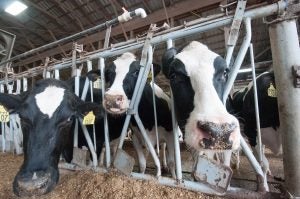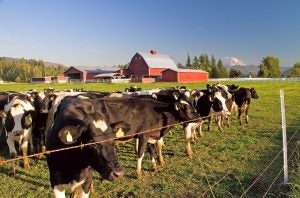As the global population grows and agricultural resources become more sparse, dairy cattle operations have become larger, multifaceted, and far more efficient. While genetic and nutritional improvements can be thanked for much of that increased efficiency, advancements in technology have also played a huge part. Not only that, but technology has tremendously improved cow welfare over the years.
An example of such technology is Fitbit-like devices that dairy cattle wear all day long. More accurately, these devices are known as automated health monitoring systems (sometimes referred to as rumination collars). Typically they look like neck collars equipped with a small electronic monitoring tag that non-invasively keeps track of the cow’s rumination time and physical movement. These systems allow farm managers to oversee a large herd without expending a great deal of time and resources to do so.
So, why exactly do cows need to wear these things? Well, just like a Fitbit records helpful data to monitor human health, rumination collars keep track of important health indicators in dairy herds. Cows are ruminants, meaning they have a four-chambered stomach consisting of the reticulum, rumen, omasum, and abomasum.
The rumen is like a large mixing vat where a lot of microbial fermentation occurs. This is what allows cows to eat forages and high-fiber feeds that humans and other non-ruminants cannot digest. Rumination, aka “cud-chewing,” is the process by which cows regurgitate partially digested food, chew it again, and re-swallow it for extra digestion. The average time spent ruminating for a healthy dairy cow is 35 to 40 percent of the day.
If a rumination collar picks up on a major deviation to this (assuming no recent changes in the cow’s ration), it can be presumed there is some other stress factor present whether it be health, environmental, or management related. That stress factor can then be addressed or eliminated in a timely manner.
The period right after calving is of particular concern in dairy cattle since the risk for diseases such as milk fever, retained placenta, metritis, and ketosis is heightened. A cow suffering from any of the conditions above will likely move around less and may go off feed, which these collars can take note of and signal to the herd manager. Their sensitivity and precise timing also makes them useful in singling out cows with metabolic and digestive disorders, so they’re valuable outside of the postpartum period too. Often, rumination collars will pick up on an issue before clinical signs are observed, which can lead to a more prompt diagnosis and earlier treatment.

To gain more insight on the usefulness of these collars in real life, I reached out to Nick Pankow, Herd Manager of Pankow Dairy Farms in Castile, New York. He shared that they have improved their herd health because they are now able to focus primarily on cows showing reduced rumination times or slowed activity.
“Instead of blindly walking around looking for sick animals, we can pinpoint animals that need attention whether it’s for indigestion, mastitis, etc.” he said.
The welfare and health benefits of automatic health monitoring systems are huge incentives for producers to make use of them. However, farmers must perform a cost-benefit analysis before investing in any type of management tool. The traditional way of monitoring herd health is by laborers who routinely (usually multiple times a day) check cows for any clinical signs of stress or abnormal behavior. Since dairy operations have grown dramatically, this has become quite a significant undertaking, and it of course leaves room for human subjectivity.
“I know exactly where an animal is that I need to check on and where she’ll need to be for treatment,” Nick says, “or I’m able to make a specific list of animals for my employees to check on while I’m away.”
Since labor is one of the biggest costs to operate a dairy farm, these collars offer the potential to reduce expenditures while providing a more objective and accurate means of evaluating herd health.

Farmers always want to avoid the untimely death of an animal — that goes without saying. But as unfortunate as it is from a welfare standpoint, what many don’t understand is that it’s also a considerable financial loss for the producer. At Pankow Dairy Farms, the cull rate has been reduced since using these collars as they are able to treat sooner and bring animals back to health quicker, according to Nick. Being able to reduce mortality rates has had a significant impact on their efforts to decrease costs.
The bottom line is that animal health and operational efficiency are among the most important factors to a dairy farm’s success. It is crucial to continually improve in both of these areas for an operation to have lasting success. Among the vast array of management tools available today, automatic health monitoring systems are one of the most promising means of maintaining a healthy, productive herd, while simultaneously reducing costs.
Michelle Miller, the Farm Babe, is a farmer, public speaker and writer who has worked for years with row crops, beef cattle, and sheep. She believes education is key in bridging the gap between farmers and consumers.



